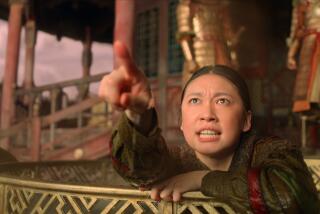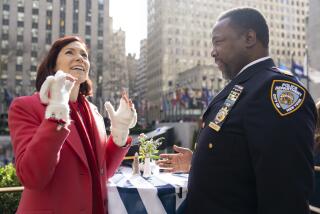‘Halt and Catch Fire’ depicts the early days of the PC revolution
In a stark Studio City office building in February, a team of six writers was huddled around a conference table breaking the season finale script of what AMC hopes to be its baton-carrying, zeitgeisty drama — “Halt and Catch Fire.”
The freshman series with the confounding computer code title — which gets explained in the season opener — is set in the 1980s during the bygone rise of the personal computer in Texas’ Silicon Prairie, the drab, often overlooked stepsister to Silicon Valley. At its center is a rebel team that dares to challenge reigning tech giant IBM with their own vision of a computer.
Lee Pace (of “Pushing Daisies,” “The Hobbit”) plays Joe MacMillan, a former IBM executive who enlists the help of Gordon Clark, an engineer played by Scoot McNairy (“Argo”) whose thwarted ambitions have led to alcoholism, and female tech prodigy Cameron Howe, played by MacKenzie Davis (“Smash”), who risks her future to join the endeavor.
The show tackles the cut-throat nature of the tech world with more dark tones and grit than HBO’s “Silicon Valley.” And the tech world is already buzzing trying to decode what company (Texas Instruments? Compaq?) or figures (Michael Dell?) serve as the basis for the story — the creators say it’s a fictional amalgamation.
At a time when TV is thoroughly intertwined with the technology of the Web (streaming, social media, et al), TV producers are now finding that those at the center of computer tech’s advancements are worth exploring. Bravo tried, rather unsuccessfully, the reality spin in 2012 with “Start-Ups: Silicon Valley,” looking at a group of twentysomething Internet entrepreneurs. Steven Bocho is doing a Silicon Valley crime show for TNT, and the recently launched comedy “Silicon Valley” has received critical praise; its geeky characters might very well host a viewing party for “Halt and Catch Fire” while high-fiving how in-the-know they are in regards to the show’s name.
“Halt and Catch Fire” premieres June 1, a week after “Mad Men” wraps the first half of its final season, a season that, somewhat suitably, dallied with the 1969 introduction of the IBM System/360.
With the cable channel, no longer an underdog, set to lose “Mad Men” in the coming year and “The Walking Dead” reaching elder statesman status, the search is on for the network to find a new crop of fresh hits. Its recent launch, Revolutionary War-set spy drama “Turn,” has been a quiet entrant. AMC is known to be patient — up to a point (e.g. cerebral conspiracy thriller “Rubicon” proved too slow for audiences).
AMC president Charlie Collier is confident that despite its sedentary quality, the new show is “the most fun you’ll have watching people build computers.”
“The first days of anything are often inelegant — there’s a lot of failure and false starts. I mean, are you calling me on a cellphone? Will you write this on a computer? We all know the fruits of these pioneers’ labor have become so meaningful in our lives,” he said by phone. “We’re eclectic by design. It is a rare network that has a show like ‘Mad Men’ and a show like ‘The Walking Dead.’ You look at what we’re adding to the network today — it’s a progression on what we’ve established. It’s not meant to be like anything else on our air.”
The show was created by newcomers Christopher Cantwell and Christopher C. Rogers (a.k.a. “The Chrises”), whose desire to tell a “men under pressure” story led them to focus on a field rife with ambiguity.
“Were people just copying ideas or were they visionaries themselves? We hear so much about Steve Jobs and Bill Gates, but who were the people in the shadow? There was so much borrowing of ideas in this fast-paced industry at the time, and that was fascinating to us,” Cantwell said.
Rogers added: “In the age of Microsoft and Apple, it’s impossible to imagine there was a moment when IBM was the presumptive winner of computers. That there was a whole other tech world outside Silicon Valley. We wanted to live in that. To show that these guys in Texas we’re doing something that was relevant and of a piece with the iPods we’re all carrying around now.”
“Halt and Catch Fire” was initially written with the intention of scoring the duo positions on a TV writing staff; Cantwell and Rogers had previously worked on the marketing team at the Walt Disney Co.
“The first writers room we walked into was our own,” Cantwell said, recalling an email from the pair’s agent that said, “We probably can’t sell this, but it’s cool. Make sure you’re not chasing ‘The Social Network.’”
Helping the neophytes shepherd the loosely based series is Jonathan Lisco (“Southland”), who serves as an executive producer and show runner. And its writing staff members — Jason Cahill, Dahvi Waller, Zack Whedon, Jamie Pachino — hail from such hit shows as “Breaking Bad,” “The Sopranos” and “Mad Men.”
But could the sort of compelling narrative or high-stake moments inherent in those shows be uncovered and made appealing for nontechies? Lisco, and even the creators, admitted they questioned the show’s potential for longevity.
“When I first heard about the show — even, candidly, when I read the first script — I wasn’t sure if we could do 50 more of it because the cloning of a PC doesn’t immediately grab you by the lapels and drag you through a narrative — coupled with the fact that I was coming from ‘Southland,’ where, when in doubt, you could break down a door and show a person at gunpoint; there’s immediate tension, immediate stakes at the human level,” said Lisco. “But I think viewers, like we did, will find there are more high-stakes and more drama than is readily seen.”
To familiarize themselves with the subject matter, the staff read Tracy Kidder’s “The Soul of a New Machine,” Steve Jobs’ biography, and watched documentaries such as Robert X. Cringely’s “Triumph of the Nerds.” And with their focus more in creating a gripping story, consultants such as Carl Ledbetter, who worked at IBM and AT&T, were solicited for guidance.
It all led to those six-plus hours of brainstorming at play this February day as they began the initial stages of writing the season finale.
“It sort of recently struck me that we have never played any sexism towards Cameron at all this season,” Waller interjected.
Later came Lisco with this reminder: “Don’t forget the origin story nature of it all and whether we’re watching people become Bill Gates or Steve Jobs or whether or not we’re watching people who get swept under the trash bin of history or are footnotes to other people’s stories.”
But the central idea that has carried the team through the 10 episodes is sentiment spoken by central character Joe MacMillan in the first episode: “Computers aren’t the thing. They are the thing that gets us to the thing.”
More to Read
The complete guide to home viewing
Get Screen Gab for everything about the TV shows and streaming movies everyone’s talking about.
You may occasionally receive promotional content from the Los Angeles Times.







